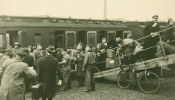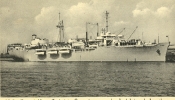Exodus from the DP camps
| At the end of the Second World War, there were about 1.8 million people who had become refugees in Europe. A proportion of them returned home shortly after the end of the war, but some couldn’t or didn’t want to return, as communist regimes had taken over their countries. At first, the refugees still hoped that their countries would regain their freedom, but, as time in the camps grew longer, these hopes faded. It was also clear to the international organizations, that these thousands of people couldn’t remain in war-ravaged Europe and that a home had to be found for them in other countries. |
Starting from 1947, Belgium and England were the first countries to accept post-war refugees: only the young and healthy were taken on for work, mainly in the coal mines. Canada, Australia and other countries followed this example, most often selecting the strongest workers or specialists from particular professions. Over time, families were also allowed to join them. The USA was the last to accept European refugees. The American programme had a special condition that each arrival had to have a sponsor, to guarantee their everyday needs and employment on their arrival in America. Usually the contract was for a year or two and the arrivals often had to repay sponsors for their tickets. Churches and other organizations actively sought sponsors and cared for the refugees themselves as well. Approximately 40,000 Latvians entered the USA through this programme, and after a while settled mainly in the largest northern cities.
A great number of refugees left Germany in 1950. Most of the camps were closed down, and the administration of the remainder was taken over by the German government.







